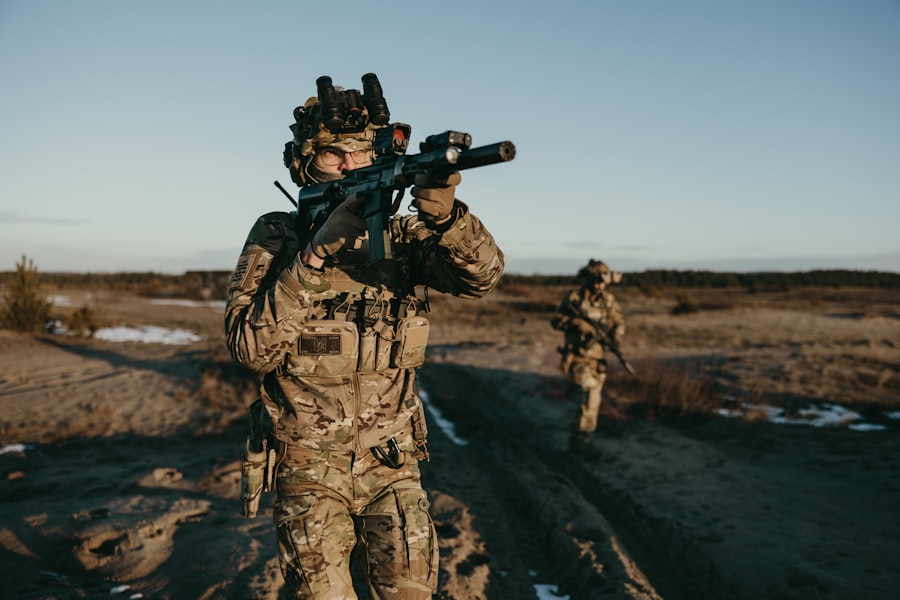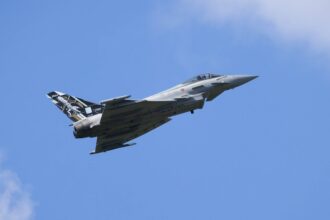Small unit tactics have long been the backbone of military operations, emphasizing the importance of teamwork, communication, and strategic maneuvering in combat scenarios. These tactics are typically employed by small groups of soldiers, often ranging from a fire team to a platoon, and are designed to maximize effectiveness in various combat situations. The essence of small unit tactics lies in their adaptability; they can be tailored to fit the unique challenges presented by different environments, enemy forces, and mission objectives.
As warfare evolves, so too must the strategies employed by these small units, ensuring that they remain effective in the face of new technologies and changing battlefield dynamics. In recent years, the introduction of advanced technologies has significantly altered the landscape of warfare. Among these innovations, drones have emerged as a game-changer, providing new capabilities for reconnaissance, surveillance, and even direct engagement.
The integration of drones into military operations has prompted a reevaluation of traditional small unit tactics, as commanders seek to leverage these tools to enhance situational awareness and operational effectiveness. As the nature of conflict continues to shift, understanding the intersection of small unit tactics and drone technology becomes increasingly vital for modern military forces.
Key Takeaways
- Small unit tactics remain essential in modern warfare
- Drones have revolutionized the battlefield
- Drones play a crucial role in reconnaissance and precision strikes
- Traditional tactics must be modified to incorporate drone technology
- Drones enhance small unit operations and effectiveness
The Evolution of Warfare in the Drone Era
The advent of drone technology has marked a significant turning point in the evolution of warfare. Historically, military engagements relied heavily on ground troops and conventional air support, with battles often determined by sheer numbers and firepower.
This shift has not only changed how wars are fought but also how strategies are developed and executed on the battlefield. As drones have become more sophisticated, their applications have expanded beyond mere surveillance. Modern drones are equipped with advanced sensors, high-resolution cameras, and even weaponry capable of engaging targets with pinpoint accuracy.
This evolution has led to a new form of warfare characterized by asymmetrical engagements, where smaller units can leverage drone technology to counter larger, more conventional forces. The ability to conduct operations from a distance while maintaining a high level of situational awareness has fundamentally altered the tactical landscape, necessitating a reevaluation of traditional military doctrines.
Understanding the Role of Drones in Modern Warfare

Drones play a multifaceted role in contemporary military operations, serving as both force multipliers and critical assets for intelligence gathering. Their ability to provide real-time data allows commanders to make informed decisions quickly, enhancing operational effectiveness on the ground. Drones can conduct reconnaissance missions over hostile territory without putting personnel at risk, offering a significant advantage in terms of safety and information acquisition.
This capability is particularly valuable in environments where traditional reconnaissance methods may be too dangerous or impractical. Moreover, drones have revolutionized the concept of air support in ground operations. With their capacity for precision strikes, they can engage enemy positions with minimal collateral damage, making them an attractive option for commanders seeking to minimize civilian casualties while achieving tactical objectives.
The integration of drones into small unit operations allows for a more nuanced approach to combat, where units can coordinate strikes with greater accuracy and efficiency. This synergy between ground forces and aerial support underscores the importance of understanding how drones can be effectively utilized within the framework of small unit tactics.
Adapting Traditional Small Unit Tactics for Drone Warfare
| Metrics | Traditional Tactics | Drone Warfare Tactics |
|---|---|---|
| Stealth | Relies on cover and concealment | Utilizes low-noise propulsion systems |
| Surveillance | Relies on human scouts | Uses onboard cameras and sensors |
| Communication | Relies on hand signals and radios | Utilizes encrypted digital communication |
| Firepower | Depends on small arms and explosives | Employs precision-guided munitions |
As drone technology continues to evolve, so too must the tactics employed by small units on the battlefield. Traditional small unit tactics often emphasize stealth, maneuverability, and direct engagement with enemy forces. However, the presence of drones necessitates a shift in focus toward integrating aerial capabilities into these established frameworks.
This adaptation involves rethinking how units approach reconnaissance, target acquisition, and engagement strategies in light of the advantages that drones provide. One key aspect of adapting traditional tactics is enhancing communication and coordination between ground forces and drone operators. Small units must develop protocols that allow for seamless integration of drone capabilities into their operations.
This may involve designating specific roles within the unit for drone operators or establishing clear lines of communication to ensure that information gathered by drones is effectively relayed to ground troops. By fostering a collaborative environment where both ground and aerial assets work in tandem, small units can maximize their operational effectiveness in the drone era.
Utilizing Drones in Small Unit Operations
The effective utilization of drones in small unit operations requires careful planning and execution. Small units must identify specific mission objectives that can be enhanced through drone support, whether it be conducting reconnaissance prior to an engagement or providing real-time intelligence during combat operations. The versatility of drones allows them to be employed in various roles, including surveillance, target acquisition, and even direct fire support when necessary.
In practice, small units can leverage drones to conduct pre-mission reconnaissance, gathering critical information about enemy positions and terrain features before engaging in combat. This intelligence allows commanders to make informed decisions about how to approach an objective while minimizing risks to personnel. Additionally, during active engagements, drones can provide continuous aerial coverage, allowing ground forces to maintain situational awareness and adapt their tactics in response to changing conditions on the battlefield.
Integrating Drone Technology into Small Unit Training

To fully harness the potential of drones in small unit operations, military training programs must evolve to incorporate drone technology effectively. This integration involves not only teaching soldiers how to operate drones but also instilling an understanding of how these tools can enhance traditional tactics. Training programs should emphasize the importance of collaboration between drone operators and ground troops, fostering an environment where both groups can work together seamlessly.
Moreover, training exercises should simulate real-world scenarios where drones play a critical role in mission success. By incorporating drone operations into field exercises, soldiers can gain hands-on experience in utilizing these technologies under realistic conditions. This practical training helps build familiarity with drone capabilities while reinforcing the importance of communication and coordination between different elements within a small unit.
Overcoming Challenges in Implementing Drone Tactics
Despite the numerous advantages that drones offer in modern warfare, challenges remain in their implementation within small unit tactics. One significant hurdle is the potential for over-reliance on drone technology, which can lead to complacency among ground troops.
Striking a balance between leveraging drone capabilities and maintaining traditional combat skills is essential for effective small unit operations. Additionally, logistical challenges may arise when integrating drones into small unit tactics. Ensuring that units have access to reliable drone technology and trained operators can be difficult, particularly in resource-constrained environments.
Furthermore, issues related to communication and data transmission may hinder the effectiveness of drone operations if not adequately addressed. Overcoming these challenges requires a concerted effort from military leadership to prioritize training and resource allocation for drone integration within small units.
Case Studies of Successful Small Unit Tactics in the Drone Era
Examining case studies of successful small unit tactics that have effectively integrated drone technology provides valuable insights into best practices and lessons learned. One notable example is the use of drones by special operations forces during counterinsurgency operations in various conflict zones. These units have demonstrated how drones can enhance situational awareness and facilitate precision strikes against high-value targets while minimizing risks to civilians.
Another compelling case study involves the use of drones for reconnaissance missions in urban environments. Small units operating in densely populated areas have successfully employed drones to gather intelligence on enemy positions without exposing themselves to direct fire. By utilizing drones for surveillance purposes, these units have been able to plan their movements more effectively and execute operations with greater precision.
Future Trends in Small Unit Tactics and Drone Warfare
As technology continues to advance at a rapid pace, future trends in small unit tactics will likely be shaped by ongoing developments in drone capabilities. Emerging technologies such as artificial intelligence (AI) and machine learning are poised to revolutionize how drones are utilized on the battlefield. These advancements could enable drones to autonomously identify targets or adapt their flight paths based on real-time data analysis, further enhancing their effectiveness as tactical assets.
Moreover, as drone technology becomes more accessible, it is expected that non-state actors will increasingly adopt these tools for asymmetric warfare. This trend will necessitate a reevaluation of traditional military strategies as conventional forces adapt to countering threats posed by smaller groups leveraging advanced technologies. The future landscape of warfare will require small units to remain agile and innovative in their approach to integrating drone capabilities into their operational frameworks.
The Importance of Flexibility and Adaptability in Small Unit Tactics
In an era defined by rapid technological advancements and evolving threats, flexibility and adaptability are paramount for small unit tactics. The ability to pivot quickly in response to changing battlefield conditions is essential for maintaining operational effectiveness. Small units must cultivate a mindset that embraces innovation while remaining grounded in core tactical principles.
This adaptability extends beyond merely incorporating new technologies; it also involves fostering a culture of continuous learning within small units. By encouraging soldiers to share insights gained from experiences with drone operations and other emerging technologies, units can collectively enhance their tactical proficiency. Emphasizing flexibility ensures that small units remain prepared to face diverse challenges while leveraging the advantages offered by modern warfare tools.
The Continued Relevance of Small Unit Tactics in the Drone Era
In conclusion, small unit tactics remain highly relevant in the context of modern warfare characterized by drone technology. While the landscape of conflict has evolved dramatically with the introduction of UAVs, the fundamental principles underlying effective small unit operations—teamwork, communication, and adaptability—continue to hold true. As military forces navigate this new era of warfare, integrating drone capabilities into traditional tactics will be essential for achieving success on the battlefield.
The ongoing evolution of warfare necessitates a commitment to innovation while honoring established tactical frameworks that have proven effective over time. By embracing new technologies like drones while maintaining a focus on core competencies, small units can enhance their operational effectiveness and remain prepared for future challenges. Ultimately, the continued relevance of small unit tactics lies in their ability to adapt and thrive amidst an ever-changing landscape of conflict.
In the evolving landscape of modern warfare, the integration of drones into small unit tactics has become increasingly significant. These unmanned aerial vehicles provide real-time reconnaissance, enhance situational awareness, and offer strategic advantages on the battlefield. For a deeper understanding of how drones are reshaping military strategies, you can explore a related article on this topic by visiting In The War Room. This resource delves into the implications of drone technology in contemporary combat scenarios, highlighting its transformative impact on small unit operations.
FAQs
What are small unit tactics in the drone era?
Small unit tactics in the drone era refer to the strategies and techniques used by small military units to effectively operate in a battlefield environment where drones and other unmanned aerial vehicles (UAVs) are prevalent.
How have drones impacted small unit tactics?
Drones have significantly impacted small unit tactics by providing enhanced situational awareness, reconnaissance, and target acquisition capabilities. They have also changed the way small units conduct surveillance, intelligence gathering, and precision strikes.
What are some key considerations for small unit tactics in the drone era?
Key considerations for small unit tactics in the drone era include understanding drone capabilities and limitations, developing counter-drone measures, integrating drone technology into small unit operations, and adapting tactics to exploit the advantages offered by drones.
What role do drones play in supporting small unit tactics?
Drones play a crucial role in supporting small unit tactics by providing real-time intelligence, surveillance, and reconnaissance (ISR) capabilities, as well as the ability to deliver precision strikes and support communication and coordination among small unit members.
How do small unit tactics in the drone era differ from traditional tactics?
Small unit tactics in the drone era differ from traditional tactics in terms of incorporating drone technology into planning and execution, adapting to the evolving threat landscape posed by drones, and leveraging the advantages of drones to enhance small unit effectiveness on the battlefield.




